Experience the Thrill of Kitesurfing in Greece
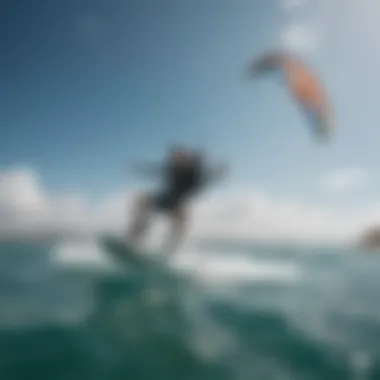
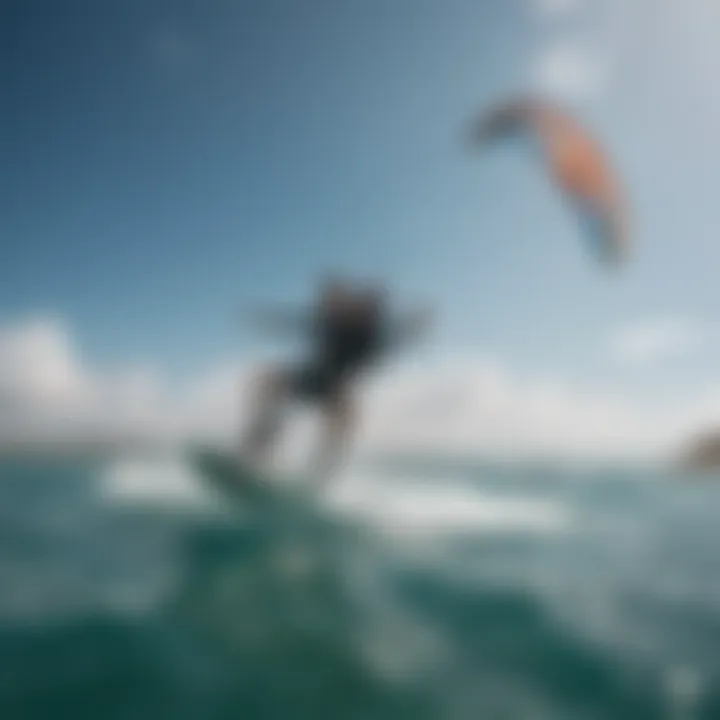
Intro
Kitesurfing in Greece isn’t just a pastime; it's a way of life that combines the thrill of the ocean with the beauty of a landscape steeped in history. As the sun beams down and the wind whips energizingly across the waves, kitesurfers find a unique blend of adrenaline and serenity, making Greece a favored destination for both novices and seasoned athletes alike. From the sandy shores of the Cyclades to the stunning coastlines of the Ionian Islands, the natural conditions here are tailor-made for the sport.
In this piece, we will embark on a journey through the enchanting world of kitesurfing in Greece. We will explore the rich history that surrounds the sport, cover the best spots for kitesurfing enthusiasts, discuss essential equipment, and provide practical tips for those eager to hit the water. Every corner of this coastal paradise offers something new and exciting, from the novice learning to ride the waves to the experienced kitesurfer perfecting aerial tricks.
Furthermore, kitesurfing is not simply a sport; it is woven into the fabric of numerous coastal communities. Here, we’ll offer insight into the thriving kitesurfing community, highlighting local events that bring people together. Environmental awareness will also be a significant focus, considering the fragility of Greece’s pristine waters and how tourism impacts them. With this comprehensive guide, we hope to illuminate the multifaceted allure of kitesurfing in Greece for both the uninitiated and the experienced!
Techniques and Skills
Kitesurfing requires a balance of skill and understanding of both the kite and the water. Knowing foundational techniques can make all the difference in your experience.
Fundamental Techniques for Beginners
Starting out, it's vital to familiarize yourself with the basic kite control, which involves managing the power and direction of the kite. Here are some key skills every beginner should master:
- Launching and Landing: Learning the proper techniques for safely launching the kite and landing it can prevent accidents.
- Body Dragging: Before you even get on the board, understand how to body drag. This skill helps retrieve your board if you lose it in the water.
- Water Start: Getting up on the board is often seen as the first big hurdle. It involves coordinating the pull of the kite and the weight of your body.
Advanced Skills for Experienced Athletes
Once you've grasped the basics, you may want to challenge yourself with advanced maneuvers. These skills often set apart the casual kitesurfer from the seasoned veteran:
- Aerial Tricks: Mastering jumps and spins can elevate your experience. Tricks like the Backroll or the Handle Pass require practice and finesse.
- Wave Riding: Taking advantage of the waves brings a different thrill. Aligning your kite for optimal lift while riding waves demands skill and timing.
- Freestyle and Kite Loops: These tricks are about style and complexity, requiring a mix of control, speed, and boldness.
Safety and Gear
While the allure of kitesurfing can be tempting, it's critical to approach with caution. Understanding safety measures and gear is paramount to enjoy the experience fully.
Essential Safety Measures in Watersports
Safety should always take precedence on the water. Here are some essential measures:
- Always Wear a Life Jacket: This is non-negotiable, especially for beginners.
- Know the Local Environment: Understanding the tides, currents, and local wildlife can ensure a safe outing.
- Check Your Equipment: Regularly inspect your gear for wear and tear.
Gear Reviews and Recommendations
Choosing the right gear can greatly enhance your kitesurfing experience. Here are some must-haves:
- Kites: Brands like Cabrinha, Naish, and Slingshot provide a variety of kites for different skill levels.
- Boards: Depending on your style, look into Directionals for wave riding or Twin tips for tricks.
- Harness: A well-fitted harness from Mystic or Liquid Force can offer comfort and support.
"Kitesurfing is not just about the board and the kite; it’s about feeling the wind and the water as a part of yourself."
This guide aims to lay down the foundation and inspire future kitesurfers. Whether you're just starting or looking to refine your skills, Greece awaits with open arms and endless waves.
Foreword to Kitesurfing
Kitesurfing is more than just a sport; it’s a thrilling blend of wind, wave, and skill. The essence of this activity lies in harnessing nature's energy to glide across water, and Greece stands out as an exceptional playground for enthusiasts. With its stunning coastlines and consistent winds, it creates the perfect stage for both beginners and seasoned riders alike. Understanding the fundamentals of kitesurfing provides a foundation for safety, fun, and skill development, ensuring that every outing on the water is not just enjoyable but also memorable.
This section introduces the reader to the basics of kitesurfing and its recent rise in popularity. As more people seek adventure in their outdoor pursuits, kitesurfing offers a unique blend of excitement and tranquility. It engages individuals on multiple levels, both physically and mentally, fostering a deep connection with the sea and the elements.
Understanding the Basics
For those dipping their toes into the world of kitesurfing, understanding the fundamentals is crucial. The essential components include a kite, a board, and the gear necessary for safety and performance. The kite acts as the engine, providing the pull, while the board allows you to ride the water. The dance between these elements defines the kitesurfing experience.
**Important aspects to consider:
**- Types of Kites: There are various types of kites, such as inflatable kites and foil kites, each serving different riding styles and conditions.
- Board Varieties: Different board shapes cater to various styles, like freestyle, wave riding, or race. Understanding the nuances of each helps surfers choose the right equipment for their skill level and preferences.
- Safety Gear: Helmets, impact vests, and harnesses aren’t just optional; they are essential for reducing risk while maximizing enjoyment.
Mastering these basics lays the groundwork for a confident start. As the saying goes, "A solid foundation builds a strong house," and in this sport, it translates to fewer accidents and a richer experience over time.
The Growth of Kitesurfing as a Sport
Kitesurfing has seen remarkable growth over the last few decades. From its humble beginnings in the late 20th century to becoming an internationally recognized sport, it has captured the hearts of many. This evolution is powered by advancements in technology, greater access to equipment, and a thriving community.
Factors contributing to the rise:
- Technological Innovation: Improved gear designs enhance performance and accessibility, inviting more riders into the fold.
- Global Events: Competitions and festivals have sprung up worldwide, showcasing kitesurfing talent and creating a vibrant atmosphere that draws spectators and participants.
- Media Influence: Social media platforms showcase breathtaking videos and stories that inspire a new generation of kitesurfers. People are increasingly attracted by the aesthetics and freedom associated with the sport.
Kitesurfing in Greece: A Unique Experience
Kitesurfing in Greece offers an irresistible combination of natural beauty, ideal conditions, and cultural richness. It’s no wonder this sun-kissed country has become a hotspot for kitesurfers from all walks of life. When one thinks about kitesurfing in Greece, images of azure waters and dramatic coastlines flood the mind. However, it’s more than just stunning vistas; the entire experience is woven into the very fabric of Greek culture.
The allure of this sport lies not only in the thrill of riding the waves but also in the communities that form around it. Local events, mentorship programs, and grassroots organizations play a pivotal role in facilitating connections among kitesurfers. The lush environments and favorable weather conditions create the perfect playground for dedicated practitioners and casual adventurers alike.
Geographical Advantages
Greece boasts a plethora of unique geographical features that make it particularly suited for kitesurfing. First off, the location of mainland Greece and its numerous islands means there are countless spots to choose from, each offering something different. The consistent winds found in places like Lefkada and Paros give early birds the chance to catch the perfect conditions almost year-round.
For example, the island of Rhodes is known for the wind known as the "Meltemi". This north wind blows steadily in the summer months, making it an ideal spot for kitesurfing enthusiasts. Notably, the shallow waters in areas like Mikri Vigla on Naxos also present less experienced kitesurfers with a safer environment to learn and grow.
Another advantage comes from Greece's diverse coastline. With both flat-water lagoons and powerful wave spots, you can find conditions that match your skill level. The interplay of mountains and sea creates a natural wind tunnel effect, leading to reliable breezes.
"When the wind blows and the waves dance, every kitesurfer feels a part of nature’s grand design."
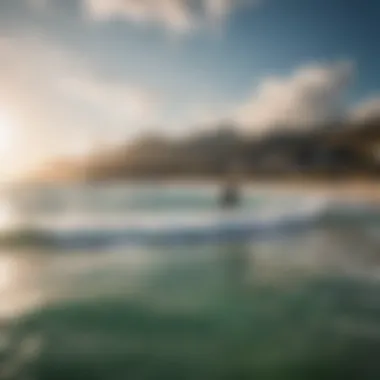
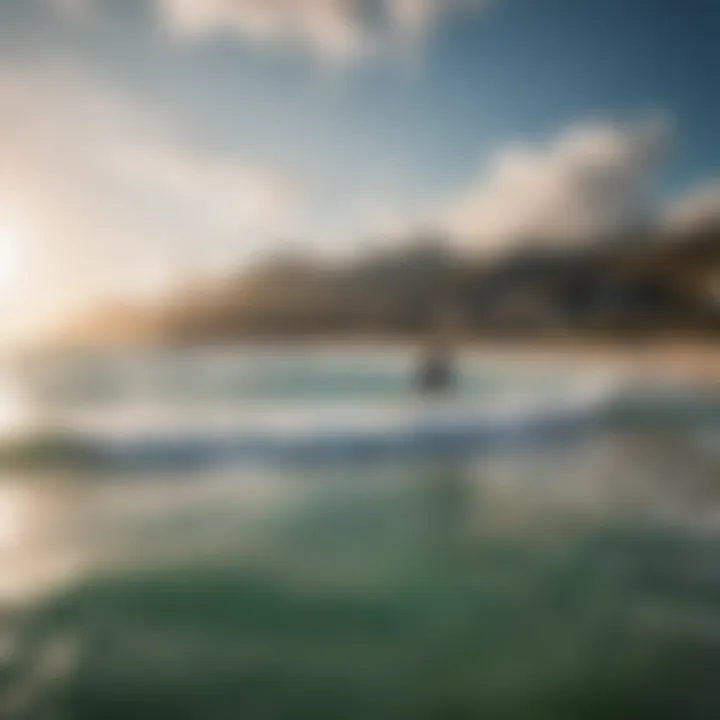
Cultural Background of Kitesurfing
While kitesurfing may be a relatively recent addition to the plethora of watersports enjoyed in Greece, its cultural implications run deep. The sport has quickly woven itself into the local fabric, evolving into social gatherings and community-building events across the nation.
Greece has a rich maritime history, and kitesurfing draws upon this deep connection to the sea. Many local schools infuse lessons with elements of Greek mythology and history, educating newcomers about ancient mariners while teaching them how to ride the waves. This approach helps to foster a sense of belonging and connection among participants.
Furthermore, the advent of social media has skyrocketed the visibility of kitesurfing, showcasing the captivating landscapes and lifestyles associated with the sport. Platforms like Instagram and Facebook have become avenues for passionate kitesurfers to share tips, tricks, and experiences. With hashtags like #KitesurfGreece gaining traction, it’s easier than ever for enthusiasts to find one another, thus facilitating deeper community interactions.
This blend of cultural pride and recreational activity ensures that kitesurfing is not simply a sport but a way to engage with the local environment and its people.
In sum, the unique geographical advantages combined with a rich cultural background not only enhance the kitesurfing experience in Greece but also solidify its position as an enticing destination for water sports enthusiasts.
Prime Locations for Kitesurfing
When it comes to kitesurfing, choosing the right location can make or break the experience. Greece, with its extensive coastline and ideal wind conditions, offers a plethora of prime kitesurfing spots. These locations are essential for both novices and seasoned riders, providing varied challenges and breathtaking views.
The Best Spots: An Overview
Lefkada
Lefkada’s reputation as a kitesurfing haven springs from its favorable wind conditions and stunning landscapes. It’s not just the wind that attracts kitesurfers; it’s the sheer beauty of the turquoise waters against sun-kissed cliffs.
One of its key characteristics is the reliable northern wind, known as the "Eric". This wind, which typically blows throughout summer, consistently provides excellent conditions for kitesurfing. It’s a popular choice for kitesurfers seeking steady winds and a friendly atmosphere.
A hidden gem within Lefkada is the beach at Vasiliki. Here, the unique geography funnels winds to create ideal kitesurfing scenarios, making it perfect for both learners and experienced boards. However, since it can get crowded during peak season, finding a quiet spot might require some patience.
Rhodes
Rhodes stands out not only for its historical landmarks but also for its reliable wind conditions. Particularly at Prasonisi, where the Aegean and Mediterranean seas converge, you find a dual beach experience. This location offers the option for both flat water and wave riding, an appealing combination that caters to a diverse range of kitesurfers.
The island's southern coast has the famous "Meltemi" wind, known for its strong and steady airflow during the summer months. This consistent wind pattern makes it a go-to destination for those wanting to hone their skills. While it is indeed beneficial, it can be challenging for novices when the wind picks up.
Paros
Paros is often dubbed the "Crown Jewel" of the Cyclades when it comes to kitesurfing. Its beaches, such as Pounda, are notorious for the infamous north winds that sweep across the area. This consistent wind, along with the shallow waters, creates a safe and inviting environment for riders of all levels.
The island also boasts a vibrant kitesurfing community, where enthusiasts can easily connect with fellow board riders and learn from each other. The only downside could be the sometimes unpredictable weather, so checking conditions is always a good practice before heading out.
Emerging Kitesurfing Destinations
Karystos
Karystos, located on the island of Evia, is a lesser-known spot gaining traction among kitesurfers. Its calm waters and stunning scenery provide a refreshing alternative to the more crowded locations. When the "Maestro" winds begin to blow, often in the late afternoon, it presents ideal conditions for all levels of kitesurfers.
What sets Karystos apart is its laid-back atmosphere and the chance to experience authentic Greek culture. Though it’s still emerging on the kitesurfing scene, the lack of crowds can be a significant draw.
Milos
Milos offers a different flavor altogether, with its unique volcanic landscapes and crystal-clear waters. The key location for kitesurfing is Plogmatikaki, where reliable winds create great conditions for enthusiast. The wind here does tend to fluctuate, making it essential to check forecasts a day ahead.
Milos is also less populated by kitesurfers, allowing for a more tranquil experience. But with fewer services compared to more established spots, it may not suit everyone’s preference for convenience.
Thasos
Thasos is another up-and-coming destination for kitesurfing, with an impressive coastline and secluded beaches. Here, you can expect to encounter great wind conditions that are generally friendly for beginners while still providing challenges for more experienced riders. The beach at Golden Beach is particularly noteworthy, with the "Etesian" winds creating moderate conditions through the summer.
Although it is still developing its kitesurfing profile, the charm of Thasos lies in its untouched beauty and less commercialized environment. This might appeal to those seeking both adventure and peace.
Local Conditions and Weather Patterns
Understanding local conditions and weather patterns is crucial for kitesurfers who want to make the most of their experience on the water. Greece, with its unique geography and climate, offers conditions that can vary dramatically depending on the season and location. Factors such as wind strength, wave size, and tidal movements can directly affect your performance. These conditions not only determine the best times to ride but also influence safety and enjoyment while kitesurfing.
Wind Conditions Throughout the Year
In kitesurfing, wind is the lifeblood of the sport. Greece is blessed with reliable wind patterns that cater to both beginners and advanced riders. The predominant winds vary by season, shaped by local climatic influences.
- Summer Season: The summer months, from June to September, are often marked by the Meltemi—a strong north-northwest wind. It's consistent and can provide ideal conditions for experienced kitesurfers seeking to challenge themselves. The wind typically picks up around noon and can range from 15 to 30 knots.
- Spring and Autumn: During these transitional seasons, wind conditions are generally milder. This period can be fantastic for newcomers since the winds are lighter, hovering around 10 to 15 knots. It’s a chance for beginners to practice without overwhelming power.
- Winter Season: Wind conditions drop significantly in winter, making it less than ideal for kitesurfing in many areas. However, some spots, particularly in southern Greece, can still offer decent conditions for those brave enough to brave the colder temperatures. It’s crucial to check local forecasts before heading out.
In sum, knowing the seasonal winds helps kitesurfers plan their trips effectively. Seasonal shifts directly correlate with the beach crowd, as many riders flock to Greece in the summer specifically for the Meltemi.
Tidal Influences on Kitesurfing
Tides play a significant role in the overall kitesurfing experience. In Greece, the tidal range is relatively small, but it can still have an effect on conditions. Understanding how tides interact with wind and local geographical features can lead to safer and more enjoyable sessions.
- Incoming Tides: When the tide is rising, it can create flat water conditions, which are favorable for beginners looking to practice basic maneuvers. Flat water allows for smoother rides and improved stability, making it less intimidating for those just starting.
- Outgoing Tides: Conversely, as the tide goes out, it can lead to choppy conditions. For experienced kitesurfers, this might be an excellent opportunity to practice advanced tricks. The chop can add an extra element of challenge, testing the rider's skill and balance.
Overall, staying informed about the tides can be just as vital as knowing about the wind. It allows kitesurfers to choose the best time of day for riding, ensuring safety and an enjoyable experience.
Important Note: Always check local tide charts before heading out. Understanding local tidal patterns can be the difference between a fantastic session and a tricky day on the water.
By diving into these local conditions, kitesurfers are better equipped to navigate Greece's diverse and beautiful waters, maximizing their time spent on the ocean.
Essential Gear for Kitesurfing
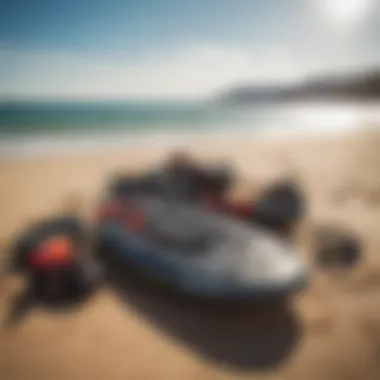
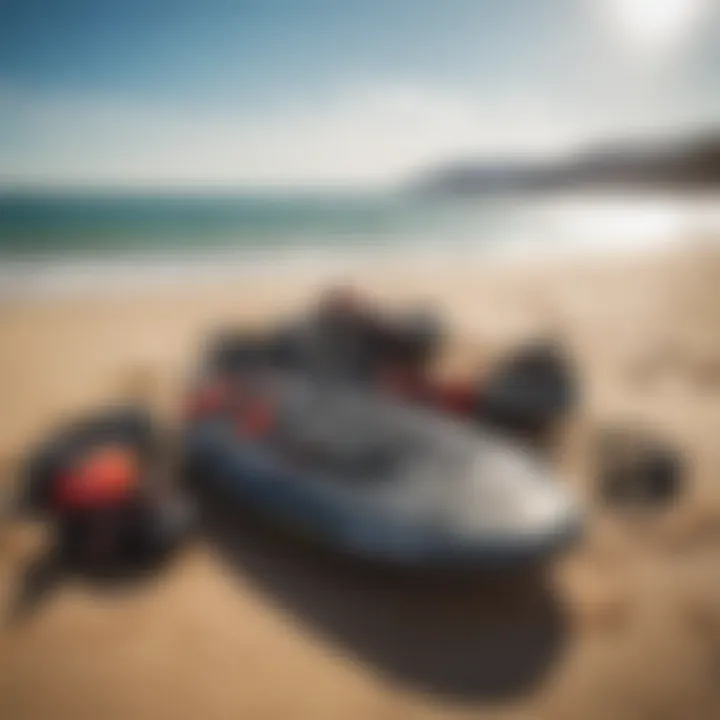
When stepping into the world of kitesurfing, having the right gear isn’t just a nice-to-have; it’s a must. The equipment you choose significantly impacts your performance on the water and, most importantly, your safety. There are elements of this sport where cutting corners can lead to a trip to the hospital instead of a day of exhilarating fun. Whether you’re just starting out or looking to upgrade your arsenal, understanding the essentials is key.
Kites and Boards: What You Need
At the heart of every kitesurfing setup is the kite itself and the board you ride on. Choosing the right kite requires consideration of weather conditions, your skill level, and even your body weight. Generally, kites come in different sizes, typically ranging from 5 to 17 meters. Smaller kites are suitable for strong winds, while larger kites cater to lighter breezes.
- Types of Kites: There are mainly two types: C-kites and bow kites. C-kites offer great performance for advanced maneuvers, while bow kites are much more forgiving and easier to handle for beginners.
- Boards: When it comes to boards, those with an intermediate skill set may prefer a twin-tip board, which provides the versatility to ride in either direction. Novices might benefit from a larger board that helps with stability. However, don’t overlook the kiteboard straps; they should be adjustable, fitting snugly but not too tightly.
Selecting the correct gear can define your entire kitesurfing experience, making it enjoyable rather than daunting. The right kite allows you to catch that sweet wind effortlessly, and a fitting board lets you ride the waves without feeling clumsy.
Safety Equipment: Staying Secure on the Water
In kitesurfing, the thrill comes with risks. Having the right safety gear is essential. Wearing a life vest isn’t just a recommendation; it’s vital, especially for beginners who may find themselves in tricky waters. Some key components of safety equipment include:
- Helmets: Protects against potential head injuries, particularly in crowded areas or during high jumps.
- Impact Vests: Designed to absorb shock during falls and provide additional buoyancy.
- Leashes: These connect your board to your body, ensuring you don’t lose it in the waters.
- Safety Release Mechanism: This is crucial. The mechanism should be easily accessible so you can detach from your kite if things go south.
"Choosing safety gear is not about how you look but how you stay in one piece."
In addition to physical gear, you must be aware of your environment and local regulations. Researching the spots you intend to visit is also wise, as some locations may have specific safety gear requirements.
Investing in quality safety equipment might feel like a hefty expense upfront, but the peace of mind it provides while you’re soaring above the waves is priceless. Furthermore, being prepared can turn a potentially dangerous situation into just another adventure in this thrilling sport.
The right blend of kites, boards, and safety gear sets the stage for both a thrilling and responsible kitesurfing experience. As you dive deeper into this exhilarating sport, remember that safety ensures you're around to enjoy it for years to come.
Techniques and Skills
Techniques and skills form the backbone of kitesurfing, encompassing the essential fundamentals as well as the advanced movements that seasoned riders often execute. Gaining a solid grasp of these techniques not only enhances one’s enjoyment but also significantly improves safety and performance on the water. For beginners, learning these techniques lays the groundwork for a rewarding journey in the sport, while advanced maneuvers elevate the overall kitesurfing experience and expand the horizons of what’s possible.
Fundamental Techniques for Beginners
For those just setting off into the world of kitesurfing, several core techniques are crucial. These skills not only enable the rider to maintain control and balance but also help them understand the nuances of kite flying.
- Launch and Land the Kite Properly: Before hitting the water, mastering the launch and landing process is vital. A controlled launch prevents accidents and allows for smoother transitions into the water. When landing, it’s key to maintain awareness of surroundings.
- Body Positioning: The way you position your body can make or break your ride. Beginners should learn the importance of maintaining a low center of gravity and adjusting their weight accordingly on the board to counteract the kite's pull.
- Joining the Water: It may seem simple, but getting onto the water while maintaining control of the kite is a skill that requires practice. Riders should focus on tilting the kite forward as they step onto the board from the beach.
- Riding Upwind: One of the most challenging aspects of kitesurfing for newcomers is the ability to ride upwind. It involves a strategy of edging against the pull of the kite, and it's crucial for returning to the starting point without drifting offshore.
- Managing the Power of the Kite: Understanding how to depower the kite in strong winds is essential for safety. Staying calm and recognizing when to let out or pull in the control lines can prevent potential hazards.
By honing these foundational skills, beginners not only set themselves up for a successful kitesurfing adventure but also build confidence as they progress in their training.
Advanced Maneuvers and Tricks
For those who've caught the kitesurfing bug, advanced maneuvers often become the focal point of their skill development. These techniques can impress others and provide an exhilarating sense of freedom on the water. Here are some notable advanced skills to aspire to:
- Jumping: One of the pinnacle moves in kitesurfing is the jump. Riders must learn how to generate lift using the kite while maneuvering their body for a smooth takeoff and landing. Angling the kite correctly during the jump is crucial to avoid crashing back into the water.
- Handle Passes: For those looking to step up their game, handle passes involve letting go of the bar mid-air and catching it again. This trick requires timing, control, and a good sense of stability.
- Toe-side Riding: This involves riding on the board's toe edge, which is a different sensation than typical heel-side riding. Mastering toe-side can lead to more advanced tricks and overall versatility.
- Rotation Tricks: Spins and other rotational moves enhance a rider’s skill level and add style to their runs. Once comfort is established with basic rotations, riders can begin experimenting with more complex sequences that involve flips and spins.
- Board Off Tricks: This daring stunt sees kitesurfers removing their board mid-ride. It requires great kite control and timing to ensure the rider remains balanced and the kite stays stable.
Getting comfortable with advanced maneuvers takes practice and patience. It’s essential to always push the limits safely. For tips and techniques shared by fellow riders, platforms like Reddit offer valuable insights.
"Mastering the art of kitesurfing means constantly challenging yourself, but with practice, the skies are the limit."
Kitesurfing Schools and Training Programs
Kitesurfing is a thrilling sport but it requires proper guidance to master it safely and effectively. This is where kitesurfing schools and training programs come into play. These institutions not only teach the techniques required for riding the waves but also emphasize safety practices, essential for both beginners and seasoned enthusiasts. Engaging in structured training increases confidence and ultimately enhances the overall kitesurfing experience.
First and foremost, there's an undeniable value in having experienced instructors to guide learners through the ropes. They can tailor lessons to individual skills, age, and fitness levels. With their wealth of knowledge, instructors help students navigate the often intimidating waters of kitesurfing for the first time.
Furthermore, schools typically use top-notch equipment which can make a difference in learning. Relying on proper gear ensures smoother sessions and can help reinforce the techniques being taught. Plus, students can also try out various equipment types, enabling them to find what they enjoy best.
"The first time I flew a kite during my lessons, everything clicked. The instructor's advice turned my fear into excitement. I couldn’t wait for my next session!" – A satisfied student
Finding the Right School
Choosing a kitesurfing school requires careful consideration. Not all schools are created equal, and several factors should be weighed before making this important decision.
- Location: Ideally, you should find a school situated in a prime kitesurfing area. Greece offers numerous stunning locations such as Lefkada, Rhodes, and Paros, all known for their favorable wind conditions. Look for schools that are based near popular kitesurfing spots for easy access to water.
- Instructor Credentials: It's crucial to check the qualifications of the instructors. Look for schools affiliated with recognized organizations like the International Kiteboarding Organization (IKO) or the British Kitesports Association (BKSA). Instructors who are certified are not just trained well, but they also adhere to high safety standards.
- Reputation and Reviews: A school’s reputation can often indicate the quality of instruction. Browsing through online reviews on platforms like reddit.com or Facebook can provide insights into other students' experiences.
- Equipment Condition: Ensure that the school maintains its gear in good condition. Ill-maintained equipment can hinder your learning process. Opt for schools that offer regularly updated and well-kept equipment.
- Class Sizes: Smaller class sizes often lead to better learning experiences. Opt for schools that offer a few students per instructor, ensuring that you receive personalized attention throughout your training.
Types of Lessons Offered
Kitesurfing schools usually provide a variety of lesson options to suit different needs and skill levels. This flexible approach is a massive plus for anyone interested in taking up the sport.
- Beginner Courses: These lessons introduce you to the basics—understanding equipment, kite handling, and safety protocols. It's a vital stepping stone for new kitesurfers.
- Intermediate Courses: Once you have the basics down, intermediate courses focus on refining your skills, practicing technique, and building confidence on the board.
- Advanced Lessons: For those looking to polish their maneuvers, these lessons often focus on jumps, spins, and more complex tricks. Here, instructors will push you to enhance your skills and perform at higher levels.
- Private Lessons: If you prefer one-on-one instruction, many schools offer tailored sessions catered to your specific needs and goals. This personalized instruction can be beneficial, especially for focusing on particular aspects you want to improve.
- Group Lessons: These are often more budget-friendly and provide the chance to engage with fellow learners. The communal spirit can boost morale and spur on learning.
Ultimately, kitesurfing schools play a key role in ensuring a productive and enjoyable experience for both novices and experienced kiteboarders. With their expertise, students can maximize their time on the water, guaranteeing that they both learn and have fun in the exhilarating sport of kitesurfing.
Safety Guidelines and Best Practices
Kitesurfing, while exhilarating and fun, also comes with inherent risks. This sport demands awareness and preparation to ensure every session at sea remains enjoyable and, most importantly, safe. Following safety guidelines and best practices helps in minimizing incidents and allowing enthusiasts to focus on the thrill of riding the waves. Without proper precautions, even the most skilled practitioner can face unexpected challenges. Thus, it’s crucial to be alert and obey established safety practices to enhance the experience.
Pre-Flight Safety Checks
Before launching into the vibrant waters of Greece, performing thorough pre-flight safety checks is not just advisable; it’s essential.
- Inspect Your Gear: Take a few moments to examine your equipment. Look for wear and tear on the lines, kites, and harness. A minor tear can quickly lead to significant issues once on the water. Each component plays a pivotal role in your safety.
- Check the Winds: Knowing wind conditions is vital. Wind speed and direction can change rapidly, affecting how your kite handles. Use local resources or mobile apps to check current conditions. If the wind is gusty or too strong, consider postponing your session.
- Safety Leash and Release Systems: Familiarize yourself with your safety systems. Ensure that your quick release mechanisms work effectively. These can be your lifeline in emergencies, allowing you to detach from the kite if needed.
- Plan Your Launch Area: Choose a clear and spacious area for launching. Look out for other kitesurfers, swimmers, or obstacles around. Always communicate your intentions with fellow riders in the vicinity.
- Buddy System: If possible, never head out alone. Having a buddy nearby not only enhances safety but also enriches the experience, providing assistance in case of mishaps.
"Preparation is the key. A well-planned session is often a safe session."
Navigating Local Regulations
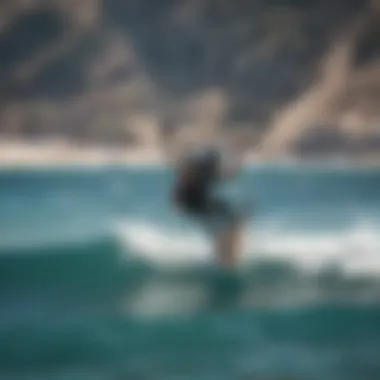
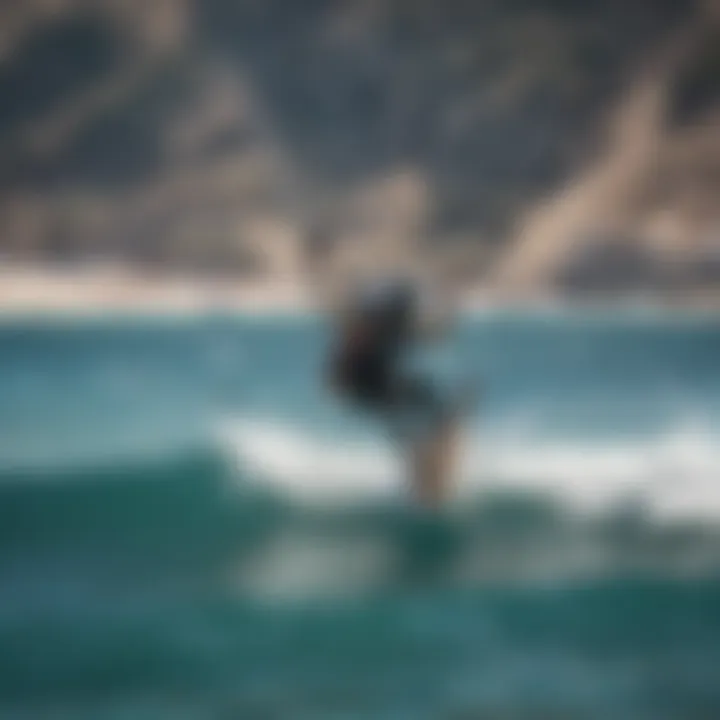
To make the most of kitesurfing in Greece, it’s essential to understand and adhere to local regulations. Each location might have its own rules, and ignorance could lead to fines or, worse, jeopardize your safety and that of others.
- Research Local Laws: Each island or spot may have different regulations regarding kitesurfing. Some areas might restrict kitesurfing during peak hours to minimize conflicts with swimmers or surfers. Before heading out, do some research or ask local kitesurfing schools about the regulations in that area.
- Respect No-Kite Zones: In many places, certain zones may be off-limits to kitesurfers, often due to safety concerns or environmental preservation efforts. Observe signage and respect these boundaries to ensure that the activity remains sustainable for future generations.
- Insurance Consideration: While not a regulation everywhere, investing in liability insurance can provide peace of mind. If something goes awry, being covered can save you from potential legal troubles.
- Notify Authorities: In areas where regulations require it, informing local authorities about your kitesurfing plans is wise. This helps them monitor activities and manage safety effectively.
- Adhere to Environmental Guidelines: Some regions highlight the necessity of minimizing the environmental impact of water sports. Make sure to follow guidelines regarding wildlife, such as maintaining distance from nesting areas and habitats.
Community and Events
Kitesurfing in Greece is not solely about the adrenaline rush of gliding over the waves; it’s also about the vibrant community that forms around this exhilarating sport. A strong community amplifies the experience for all participants, from newcomers to seasoned pros. One of the main benefits of being part of such a community is the camaraderie it fosters. When kitesurfers come together, they share stories, tips, and a mutual appreciation for the sea, creating bonds that often last a lifetime.
Local Kitesurfing Networks
Local kitesurfing networks are often the backbone of the sport in Greece's picturesque coastal towns. From casual meetups at popular beaches to organized group sessions, these networks allow enthusiasts to connect easily. Many towns have established clubs that not only promote the sport but also organize events, workshops, and group kiting sessions.
- Networking Opportunities: Engaging with other kitesurfers is invaluable, as each person offers different experiences and insights. This collective knowledge can comprise everything from equipment recommendations to tips on mastering tricky maneuvers.
- Access to Resources: For those interested in elevating their skills or learning about the latest gear, local networks often have access to essential resources. This includes contacts for instructors, rental shops, and even accommodation tailored for kiting enthusiasts.
- Mentorship: New kitesurfers can find mentors who are willing to share their knowledge. Having someone with experience can make learning not just quicker but also safer.
These networks often keep active social media pages on platforms like Facebook, where members can share photos, organize group outings, and discuss recent conditions. This connection to the community makes each individual feel like part of something bigger.
Annual Competitions and Festivals
In Greece, annual competitions and festivals dedicated to kitesurfing play significant roles in elevating the sport's profile. These events do much more than just showcase top talent; they invite participants from varying skill levels, encouraging participation and celebrating the culture of kitesurfing.
- Skill Development and Competition: Competitions come with a competitive edge, pushing participants to improve their skills. Facing off against others in a friendly environment can be a huge motivator.
- Cultural Exchange: The influx of local and international kitesurfers during these events fosters a unique cultural exchange. Participants share their traditions, music, and styles on the water, enriching the overall experience.
- Spectacle and Audience Engagement: Events like the Kitesurfing World Cup held in spots like Kefalonia draw large crowds. These festivals turn the beaches into lively arenas where onlookers can cheer on athletes and participate in side activities, creating a festival atmosphere.
"Competitions not only challenge your skills but also strengthen the bonds within the community, making it feel like a family of water sports enthusiasts."
These gatherings also often incorporate parties, live music, and local cuisine, providing an all-around enjoyable experience that goes beyond the water. Through these events, the connection between kitesurfers continues to grow, promoting both sport and local culture together in a most spectacular fashion.
Environmental Considerations
Kitesurfing isn’t just a thrilling pastime; it brings to the forefront serious conversations about our environment. In Greece, where the sea meets the sky in a vibrant dance of winds and waves, discussing environmental considerations is not just important—it's essential. As much as kitesurfing offers joy to many, it can influence marine ecosystems in both positive and negative ways. By understanding these impacts, we can not only enjoy the sport but also protect the beautiful landscape we cherish.
Impact of Kitesurfing on Marine Life
- Disturbance of Breeding Grounds: The noise and activity of kitesurfers can disrupt marine creatures during crucial breeding times.
- Damage to Coral Reefs: Initiating a sport close to coral reefs can result in physical damage that takes years to recover.
- Pollution: Increased foot traffic and waste can contribute to pollution in otherwise pristine areas.
Understanding these factors is vital for both newcomers and seasoned kitesurfers. By ensuring that our actions during kitesurfing respect the local marine life, we can help protect these ecosystems for future generations. Kitesurfing should not come at the cost of the aquatic life inhabiting these waters.
Sustainable Practices to Adopt
Adopting sustainable practices in kitesurfing makes a significant difference. The beauty of Greece’s coastlines comes with a responsibility to ensure that they remain as pristine as we found them. Here are some sustainable practices kitesurfers can implement to lessen their ecological impact:
- Stay Informed: Understanding the local marine life and habitats is essential. Knowing where to kite and where NOT to kite protects sensitive areas.
- Use Eco-Friendly Gear: Selecting kites and boards made from sustainable materials can minimize waste. Some companies focus on eco-conscious production methods.
- Proper Waste Disposal: Always carry out what you bring with you. This small action dramatically lessens pollution in the coastal areas.
- Respect Local Wildlife: If you encounter marine life, slow down and give them space. This is a fundamental way to keep both kitesurfers and marine creatures safe.
- Participate in Clean-Up Events: Getting involved with local beach clean-up efforts not only improves the environment but also builds community among kitesurfers.
"Kitesurfing can be a double-edged sword. We must learn to wield it wisely while enjoying the thrills it brings."
It is about creating a balance between enjoying the sport and ensuring we leave a minimal footprint on these beautiful landscapes. As enthusiasts, we must foster a culture of awareness among each other to further support the environment in which we find so much joy. With thoughtful actions, kitesurfers can ensure that Greece remains a top destination for years to come, both for thrill-seekers and for conserving its rich marine ecosystems.
Exploring Kitesurfing Culture
Kitesurfing in Greece isn't merely a sport; it's a culture that thrives in the sun-soaked coasts and endless blue seas. The allure of this pastime goes beyond the thrill of riding the waves; it intertwines with the rich traditions and lifestyle of the Greek people, creating a unique atmosphere that both locals and visitors cherish. This section seeks to delve into how Greek culture shapes kitesurfing, alongside the increasing impact of social media in popularizing this vibrant activity.
Influences of Greek Culture on the Sport
Greek culture has a long history of maritime activity, influencing everything from local cuisine to festivals. This rich heritage is reflected in the way kitesurfing is practiced and celebrated throughout the islands.
Firstly, the Greeks have a deep respect for nature and the sea. This respect manifests in kitesurfing through practices that emphasize sustainability and environmental awareness. Local kitesurfers often engage in beach clean-up initiatives, ensuring that the stunning shores remain pristine for future generations. This connection to their surroundings enhances the experience, making every ride on the water a celebration of both joy and responsibility.
In addition, many of the kitesurfing spots are steeped in history. For instance, participating in a session at a site like Lefkada connects riders not only with the wind and water but also with an area known for its ancient ruins and breathtaking landscapes. Riders don’t just catch the breeze; they also absorb the spirit of their surroundings, fostering a sense of belonging and respect for Greek heritage.
Furthermore, local traditions are often integrated into kitesurfing events, whether it’s the vibrant music that plays during competitions or the artisanal craft markets that pop up at popular kitesurfing spots. The engagement with local artisans helps to enrich the overall experience. When kitesurfers gather, they often exchange not just techniques, but also stories and lore, which strengthens community ties.
The Role of Social Media in Kitesurfing
In an age where technology penetrates every aspect of life, social media has emerged as a double-edged sword within the realm of kitesurfing. On one side, platforms like Instagram and Facebook are vital for promoting events, sharing tips, and showcasing stunning locations across Greece. For example, a quick search might lead someone to a stunning video of kitesurfers dancing across the waves at Rhodes, sparking interest and curiosity in newcomers who might not have otherwise been exposed to such breathtaking vistas.
However, there are also drawbacks. With vast exposure comes pressure; many kitesurfers feel compelled to perform not just for themselves, but for their digital audience as well. There’s often a sense of competition that arises—a desire to capture the next viral moment. This can lead to a shift in focus from the joy of the sport to the necessity of style.
"Social media is a powerful tool, but it can blur the lines between enjoyment and performance. Ride for yourself first!"
Moreover, social media has birthed online communities where enthusiasts can share experiences and knowledge. Reddit forums and Facebook groups abound with discussions on gear, technique, and travel tips. These platforms serve as an invaluable resource, allowing kitesurfers to connect with each other across the globe, sharing insights and celebrating each other’s achievements.
In summary, exploring kitesurfing culture in Greece reveals a tapestry woven with tradition, respect for nature, and modern interconnectedness. While the past influences the present, the future of kitesurfing is being shaped by both cultural heritage and the rapidly evolving technological landscape.
Epilogue
Kitesurfing in Greece stands out not just as a thrilling sport, but as a vibrant expression of culture and nature. This article has walked you through the essential aspects that elevate this activity, from historical influences to the breathtaking locations available. The allure of kitesurfing is deeply intertwined with Greece’s rich geography and favorable winds, making it a top destination for enthusiasts around the world.
The Future of Kitesurfing in Greece
Looking ahead, the future of kitesurfing in Greece appears buoyant. The sport is anticipated to continue growing, with more schools opening and advanced gear becoming more accessible. As global awareness of environmental impacts rises, local operators are also likely to adopt more sustainable practices, ensuring that the pristine waters of Greece remain untouched. Initiatives aimed at protecting the coastline and educating participants about their ecological responsibilities will become more integral to kitesurfing culture.
Moreover, the tourism industry in Greece is poised to adapt; creating tailored kitesurfing packages can offer new revenue streams while enhancing visitor experiences. With advancements in technology, aerial photography and videography will open avenues for documenting and sharing experiences widely on social media, thereby attracting an even larger audience.
Final Thoughts for Enthusiasts
For both newcomers and seasoned kitesurfers, embracing the experience in Greece offers a chance to connect with nature like no other. This combination of adventure and serenity is unlike any other. Take some time to understand the environment—wind patterns, water filters, and local conventions. Engaging with the local community can enhance your skills and broaden your understanding of the sport.
Don’t forget the importance of safety, not just for yourself but also for the marine ecosystem. Always prioritize conscious kitesurfing and respect the natural habitats around you.
In summary: Kitesurfing in Greece is not just another water sport; it’s a gateway to discovering stunning landscapes, bonding with fellow enthusiasts, and crafting unforgettable memories. Savor your journey, respect the waters, and keep riding the winds.















